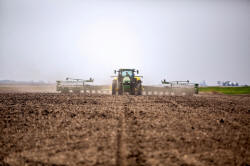Biden farm debt relief plan to exclude thousands of minority farmers,
data shows
 Send a link to a friend
Send a link to a friend
 [December 17, 2021] By
Leah Douglas and Christopher Walljasper [December 17, 2021] By
Leah Douglas and Christopher Walljasper
WASHINGTON/
CHICAGO (Reuters) - The latest
version of the Biden administration’s plan to forgive billions of
dollars in farm debt - initially targeted at farmers of color - will
exclude thousands of its originally intended recipients because of a
change in loan eligibility, according to government data reviewed by
Reuters.
The debt relief program had been cast by President Joe Biden’s
administration as a form of restitution for decades of discriminatory
lending practices by the U.S. Department of Agriculture (USDA) against
Black and other minority farmers.
Farmer advocates say changing the program risks undermining
already-shaky trust between the government and minorities in
agriculture.
"If Black farmers don’t get this debt relief that they’ve been promised,
it’s almost like a contract that’s being broken,” said Cornelius
Blanding, executive director of the Federation of Southern Cooperatives,
which represents Black farmers.

The administration first attempted to forgive $4 billion in debt for
farmers of color through the American Rescue Plan Act (ARPA) in April.
The USDA sent letters to 14,120 farmers of color between May and
September, promising $2.4 billion in debt relief, according to data from
USDA's Farm Service Agency (FSA) obtained by Reuters through a Freedom
of Information request.
But white farmers blocked the program in court, arguing its racial
criteria made it unconstitutional.
The new program, included in the Build Back Better Act (BBBA) now being
hashed out in the Senate, would make farmers eligible for debt relief
according to their economic insecurity rather than race.
But it would also relieve debt only for farmers who have loans directly
through FSA, excluding farmers with outstanding private loans guaranteed
by the agency.
That means some 15%, or 2,100, of the 14,120 farmers of color who
received letters from USDA this spring would no longer meet the criteria
because they hold guaranteed, rather than direct loans, according to FSA
data.
The program prioritizes farmers with direct loans because they are
generally more economically distressed than guaranteed borrowers, said a
staffer on the Senate Agriculture Committee, who asked not to be named
because they were not authorized to speak on the issue.
In addition to eligibility changes, the use of economic metrics could
itself also leave out some farmers of color, said a congressional
staffer familiar with the policy details, but who also asked not to be
named.
"I don't think there's any potential formula that’s going to capture
100% of the socially disadvantaged farmers who would have gotten the
debt relief before.”
USDA declined to discuss the details of the program, saying it was under
the purview of Congress, but acknowledged the government's frayed
relationship with minority farmers.
“Let’s be clear: we have a lot of work to do to rebuild trust. The
American Rescue Plan provided opportunities to do that, but
unfortunately, court orders have put some of the key provisions on
hold," said Dewayne Goldmon, USDA senior adviser on racial equity.

'PAY OFF YOUR DEBT ... GET ANOTHER LOAN'
Luke Meeks, 39, is a Lakota Native American rancher who, like his
brother and parents, operates a ranch in southwestern South Dakota. He
was among the farmers of color who received a USDA letter promising debt
relief under ARPA.
Forgiveness of his $500,000 in FSA debt would be a game-changer for
Meeks, who has been trying to move his family to a better location for
his children’s education, but cannot get bank approval.
“It would simplify everything,” he said.
But some of his loans are guaranteed, so they would not be eligible for
relief under the BBBA program. Without the debt relief, Meeks said his
options are limited.
[to top of second column] |

A farmer drives a new tractor and planter during spring planting at
a farm in Malvern, Iowa, U.S., April 27, 2021. 2021. REUTERS/Rachel
Mummey/File Photo

“You just kind of get by,” he said. “Take out a big loan, sell your calves, pay
off your debt, then you get another loan.”
Guaranteed loans are granted by banks to farmers who are unable to qualify for a
traditional loan. Such loans are, on average, three times bigger than direct
loans, according to FSA data, and are backed up to 95% by FSA.
John Boyd Jr., a Virginia farmer and president of the National Black Farmers
Association (NBFA), said he was worried the new version of the debt-relief
program would prove disappointing to many Black farmers too.
“Every time we’re thrown in the pot with everybody else, we don’t get the
money,” he said.
The Department of Justice is still defending the ARPA debt program in court. But
the government is unlikely to win that case, said Jessica Culpepper, a senior
attorney with Public Justice who represents NBFA and the Association of American
Indian Farmers in the litigation.
The judge in the U.S. District Court in the Northern District of Texas, where
the lawsuit is being heard, is likely to follow a Sixth Circuit Court of Appeals
decision in May that deemed another ARPA program that sought to allocate relief
by race to be unconstitutional, she said.
Farmers of color have alleged for decades that they face discrimination from
federal and local FSA offices in accessing loans and services.
USDA has settled discrimination lawsuits previously with farmers who are Black,
Hispanic, Native American or female, though minority farmers have argued the
settlements have been inadequate.
The U.S. Government Accountability Office found in 2019 and in 2021 that
minority farmers still receive a disproportionately small share of farm credit.
BANK LOBBYING
The exclusion of guaranteed loans from the new program comes after lobbying on
the issue by the banking industry.

In early April, the American Bankers Association (ABA), Independent Community
Bankers of America (ICBA), and National Rural Lenders Association warned USDA in
a letter of “adverse consequences” to bank incomes if guaranteed loan portfolios
were suddenly paid off.
Those consequences could include a loss of interest revenue on loans, or loss of
premiums on loans traded in the secondary markets, the letter said.
Under the current version of the BBBA plan, guaranteed borrowers would still be
eligible for $1.02 billion in loan modifications, which could include
reamortization or lowering interest rates, according to a USDA official.
At the ABA Agricultural Bankers Conference in November, FSA administrator Zach
Ducheneaux called on banks to grant farmers of color with guaranteed loans extra
flexibility because they would not receive the anticipated relief.
“We are going to have borrowers in your portfolios making plans based on that
letter,” he said to the audience of bankers, his face flushed and clearly angry.
"It’s got my damn signature on it.”
Some 68% of the farmers receiving the letters had responded to USDA verifying
their debt was accurate by late September, according to the latest FSA data
available. The agency is still accepting responses from farmers eligible for the
ARPA program, said a USDA official.
(Reporting by Leah Douglas in Washington and Christopher Walljasper in Chicago;
Additional reporting by P.J. Huffstutter in Chicago; Editing by Richard
Valdmanis and Matthew Lewis)
[© 2021 Thomson Reuters. All rights
reserved.] Copyright 2021 Reuters. All rights reserved. This material may not be published,
broadcast, rewritten or redistributed.
Thompson Reuters is solely responsible for this content.
 |